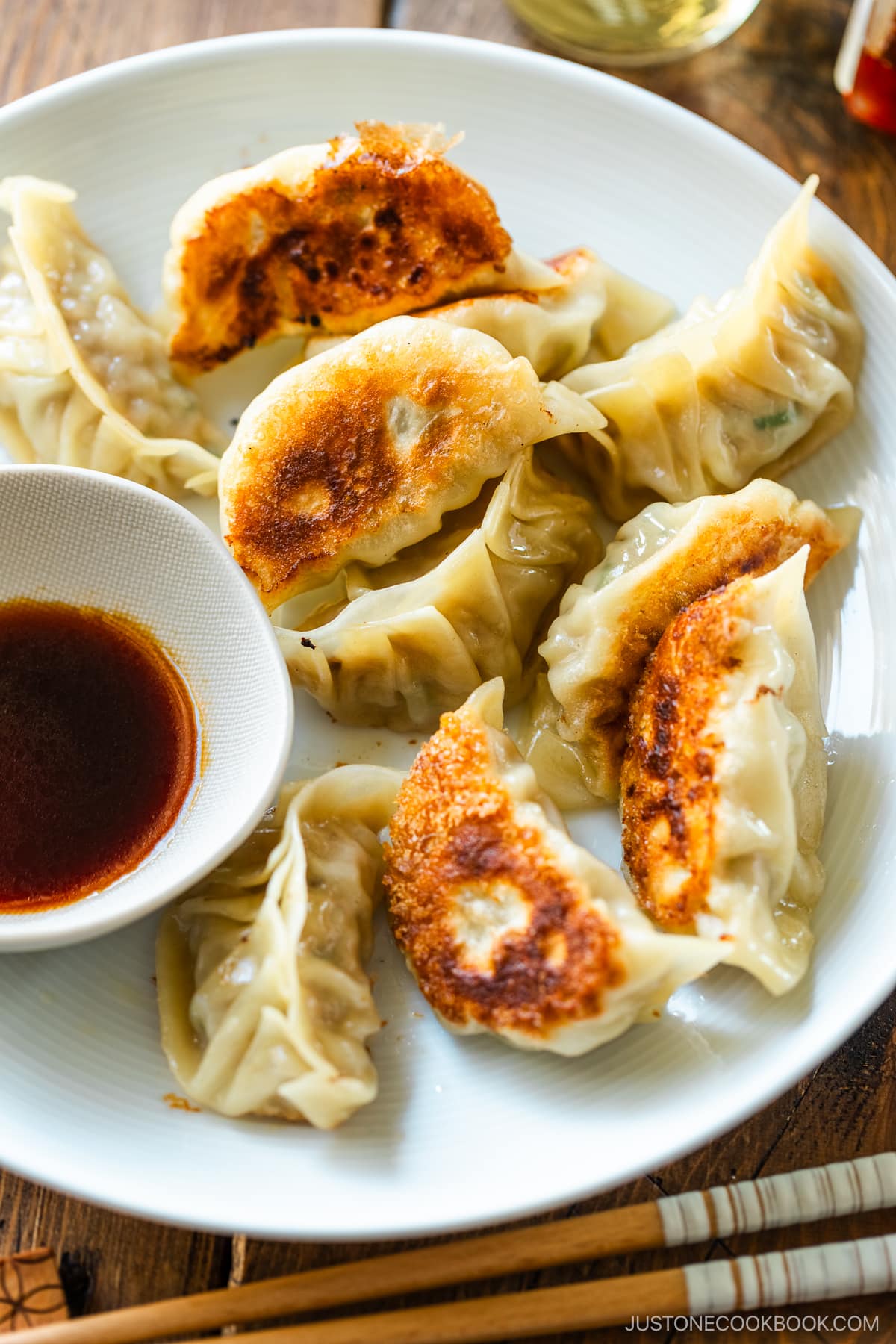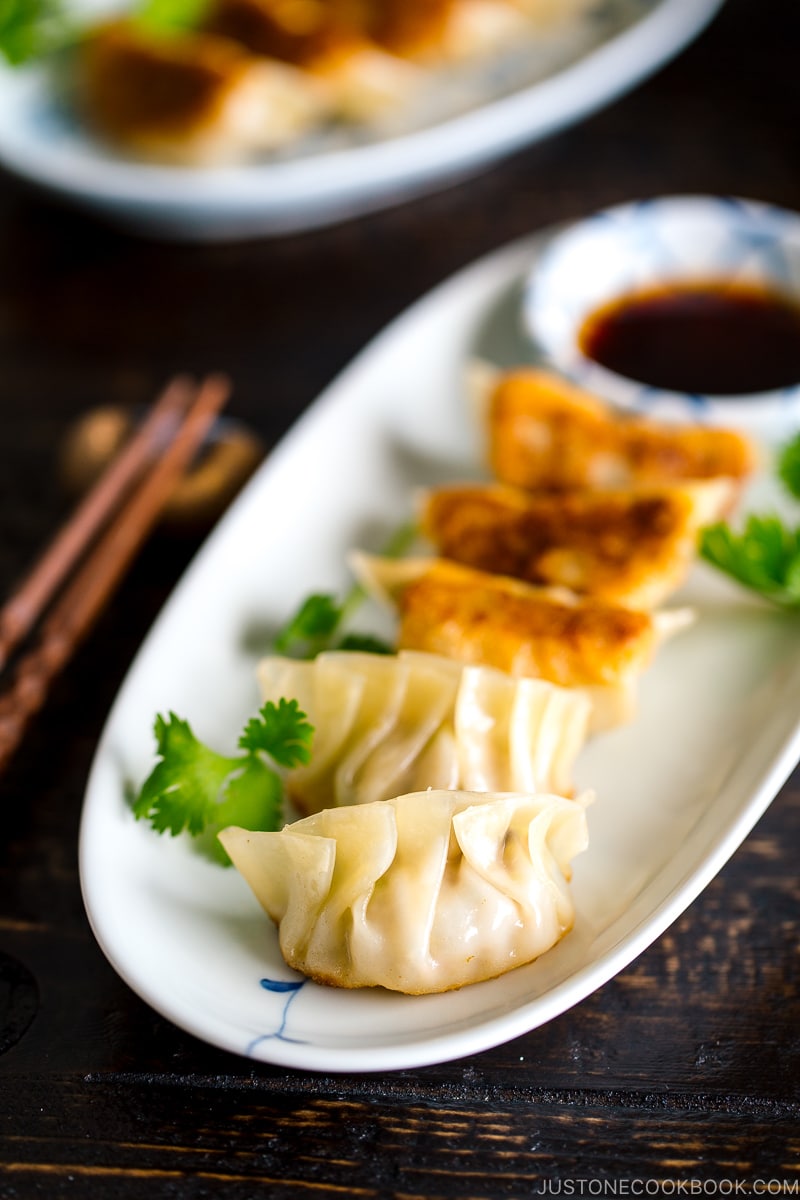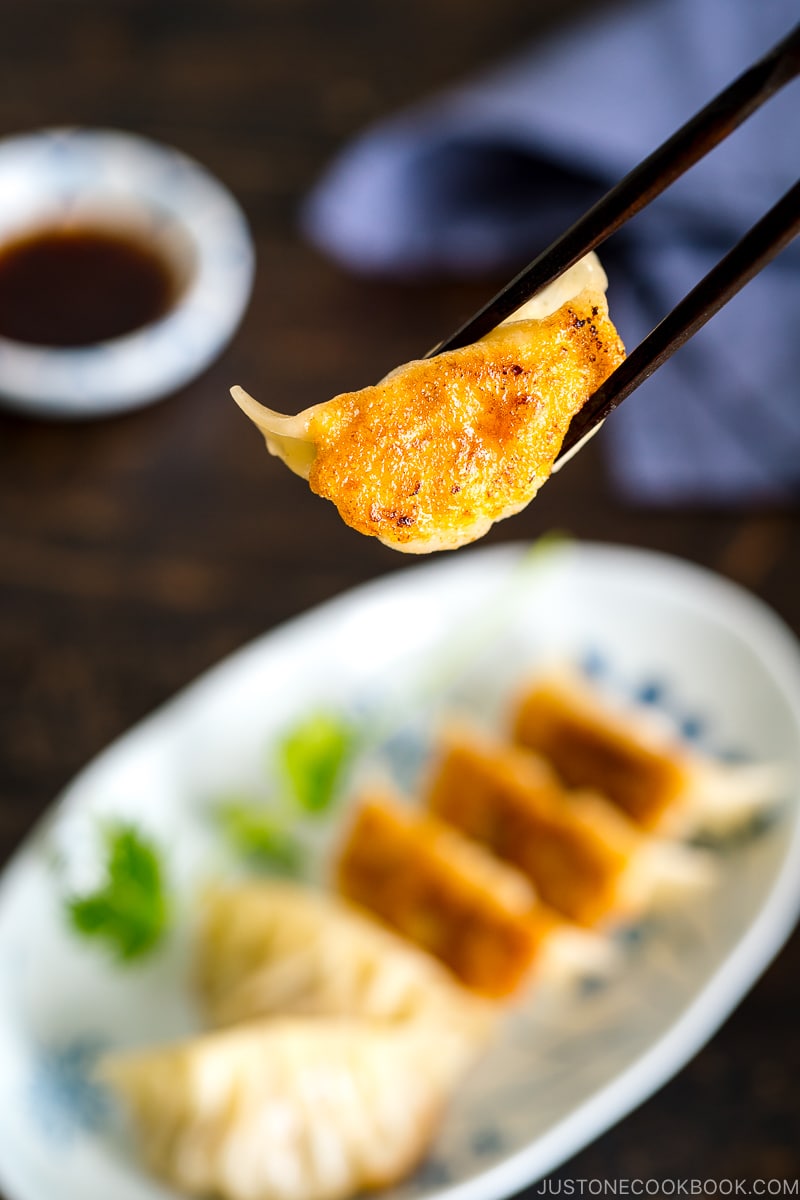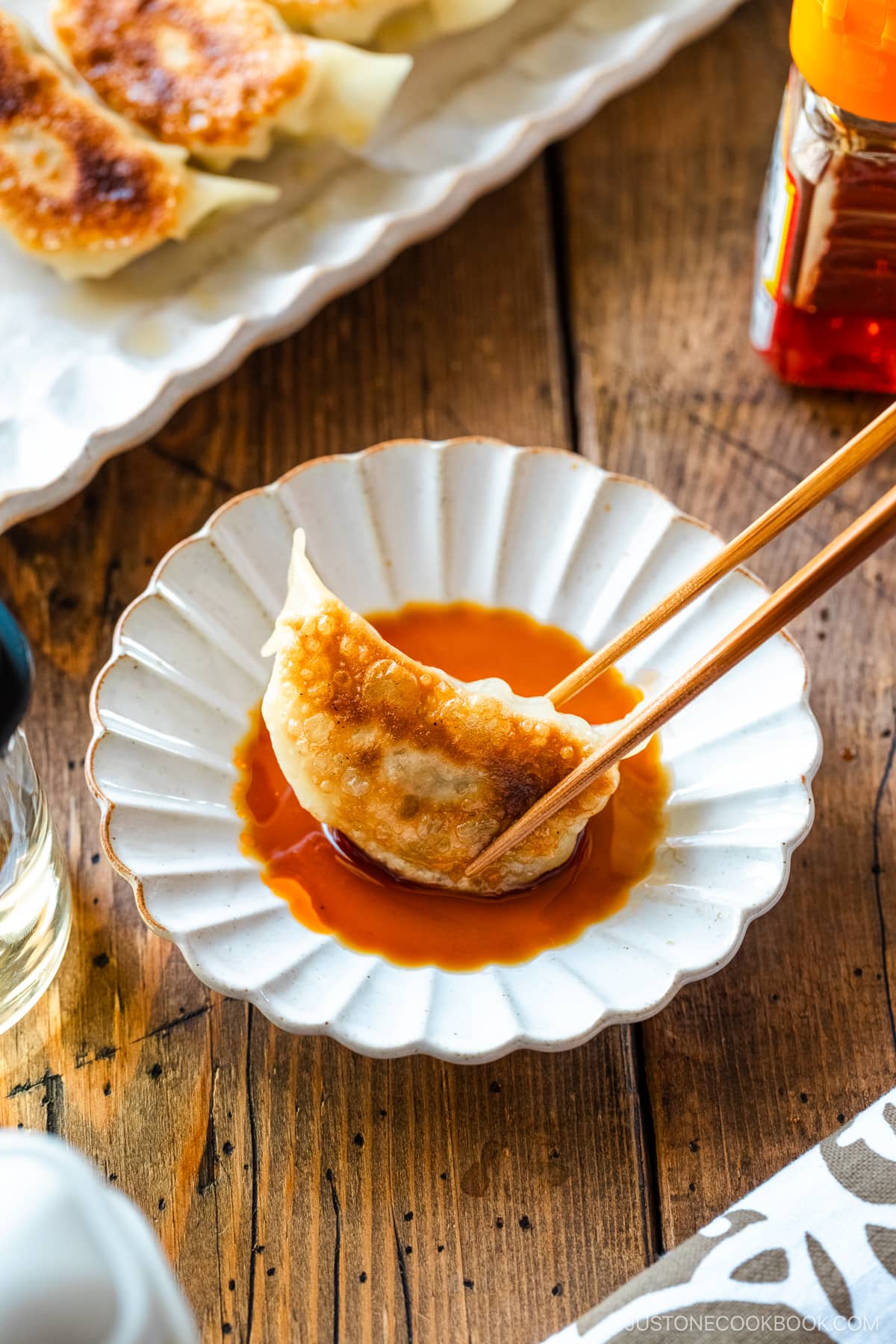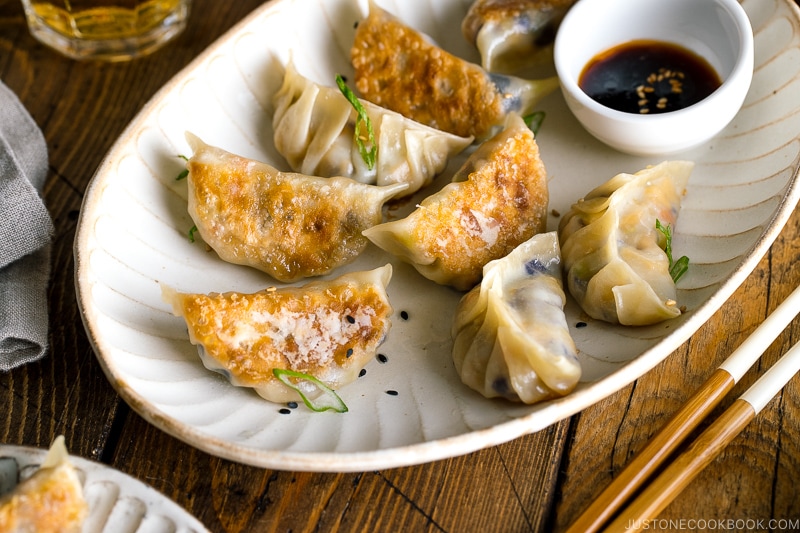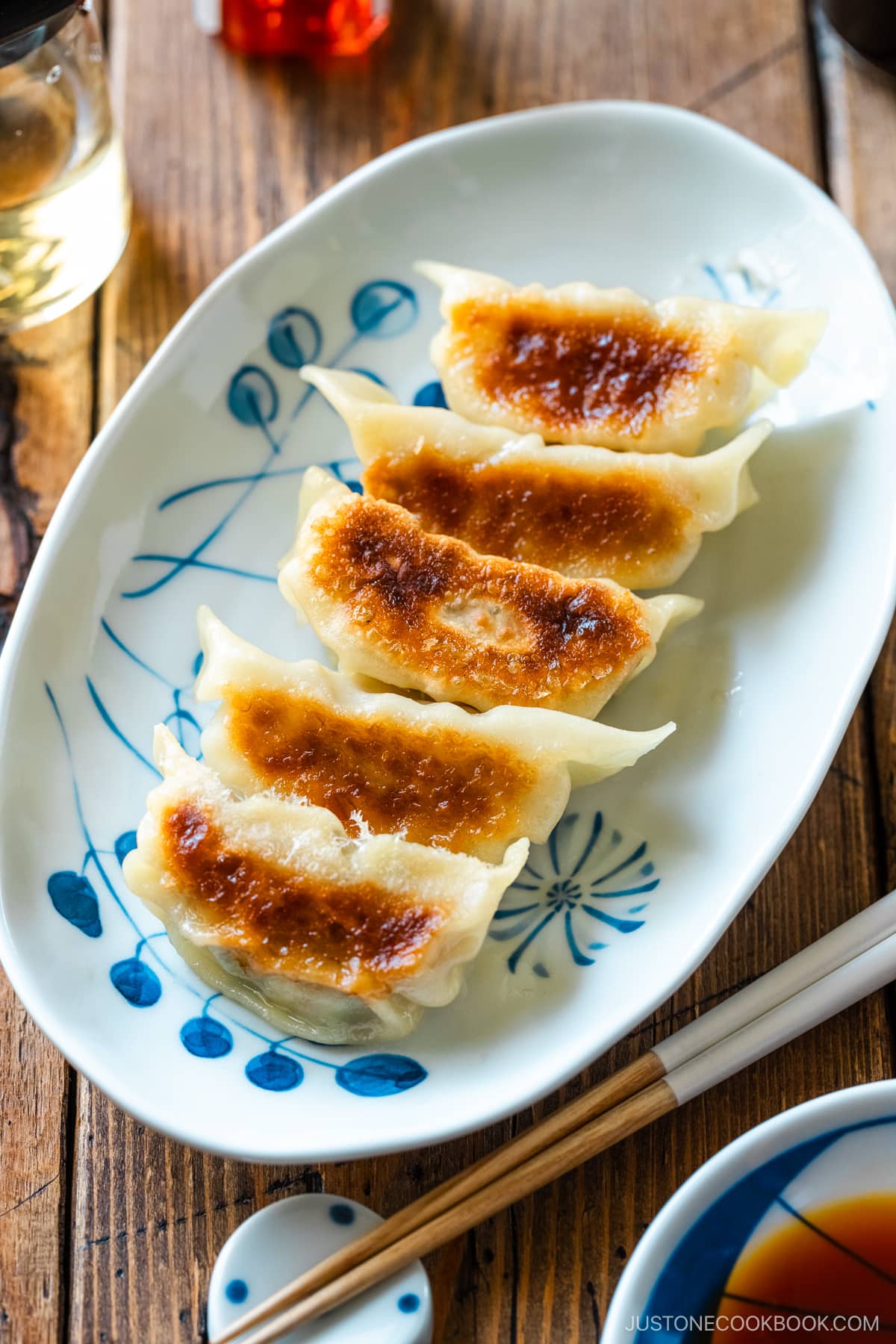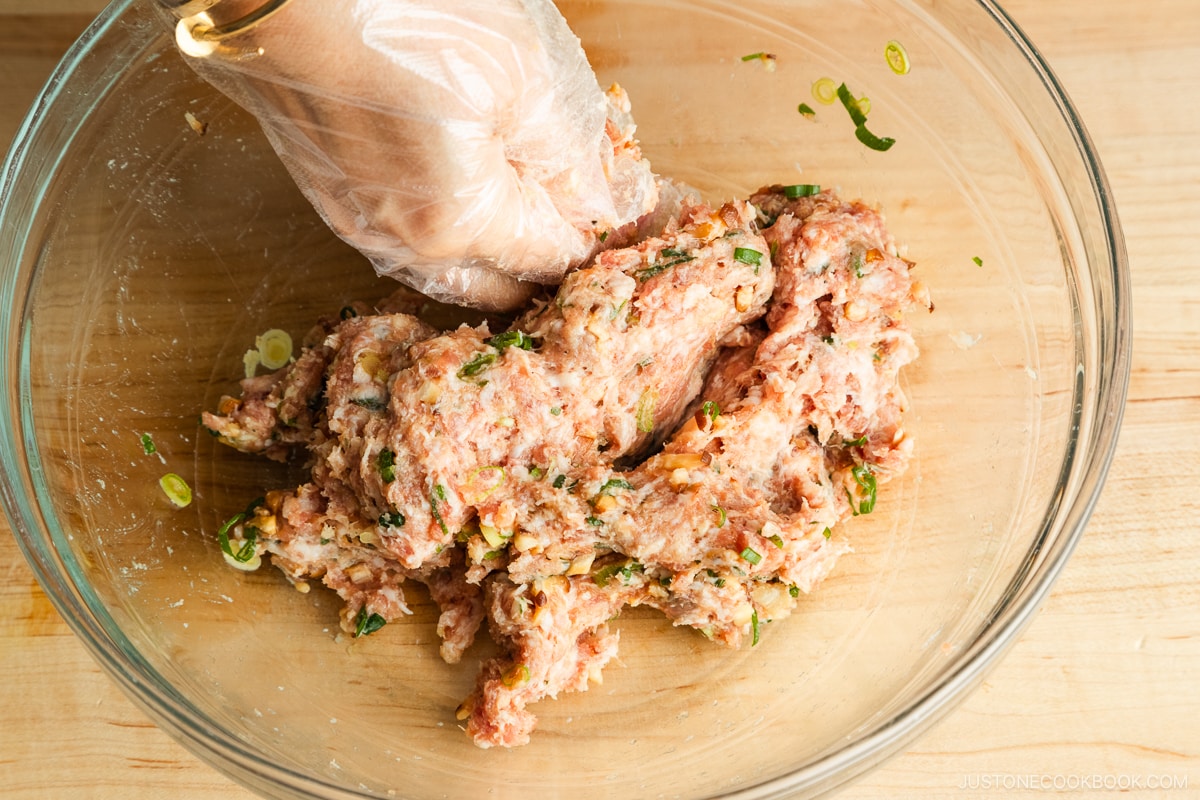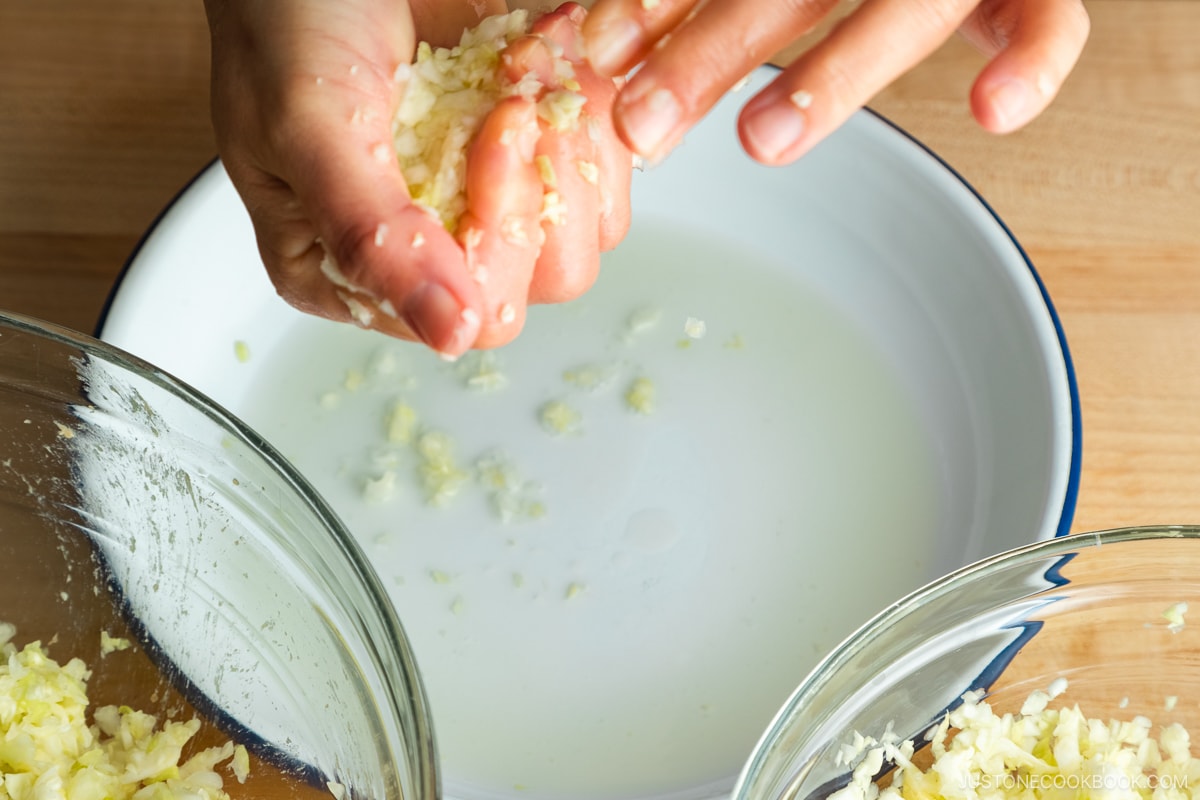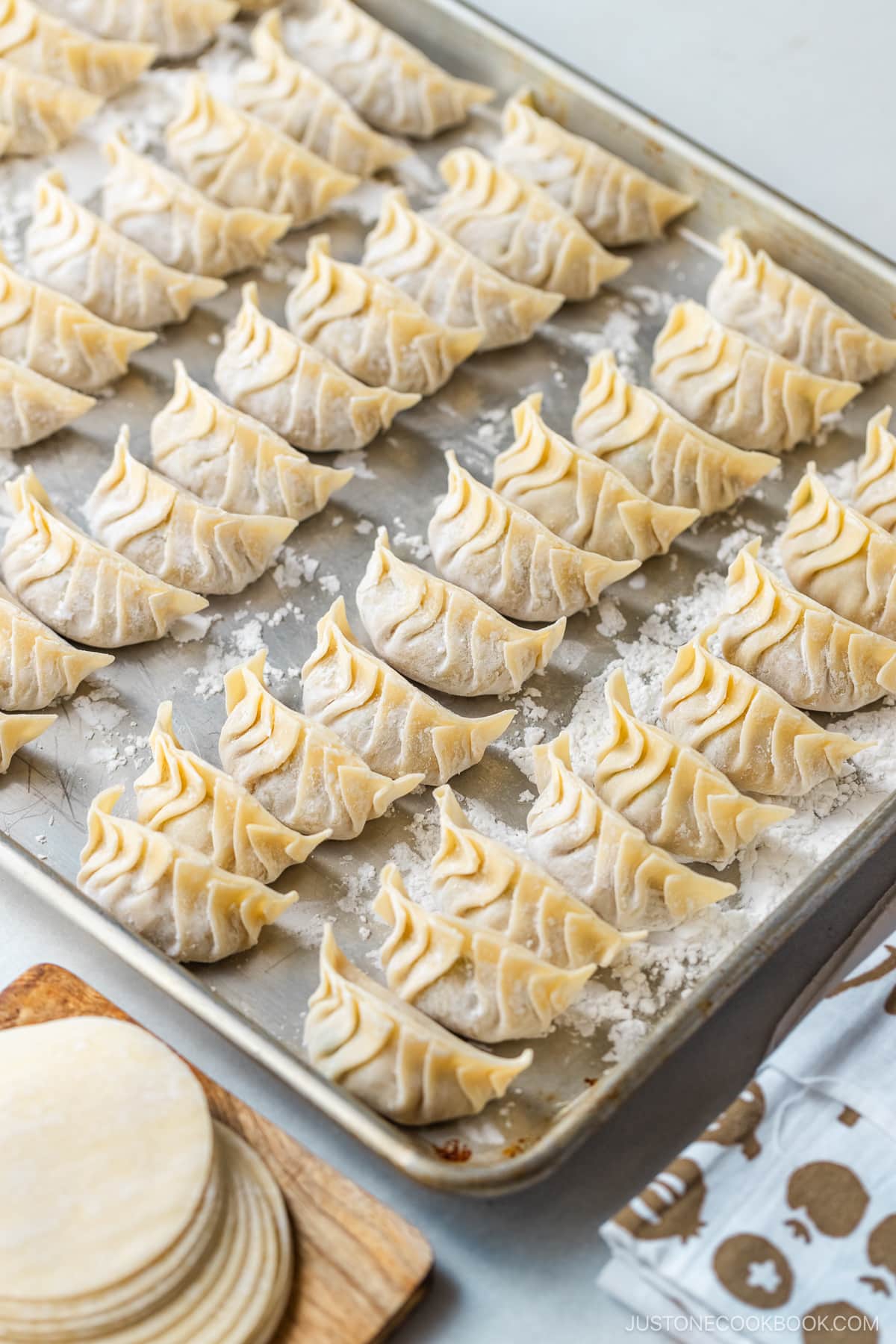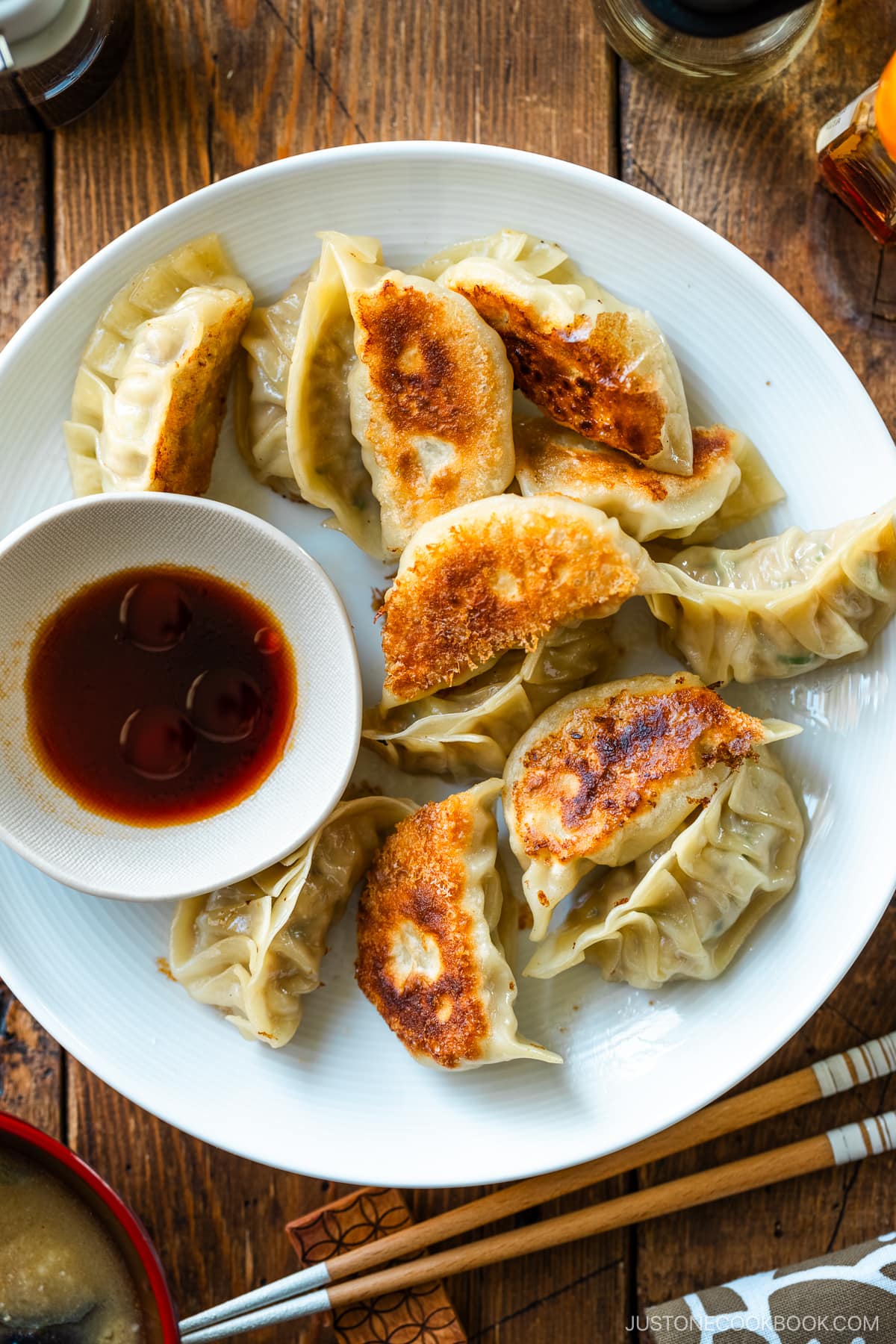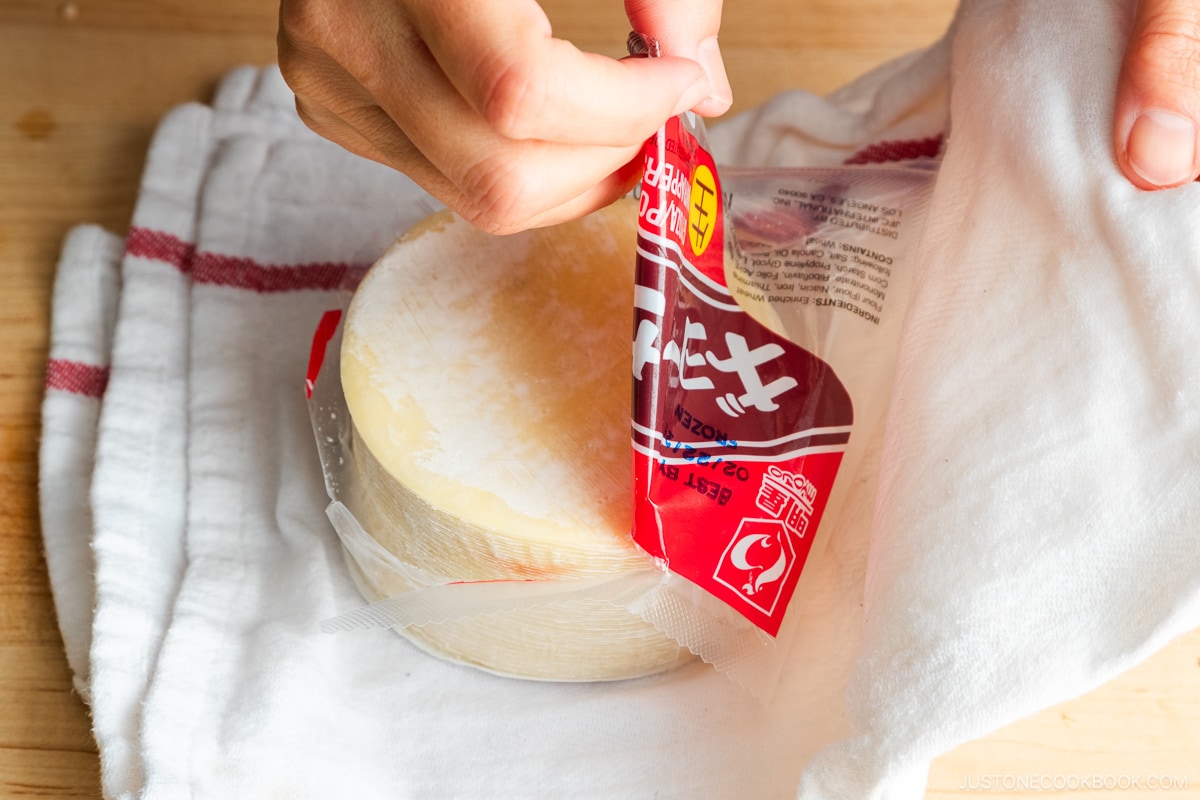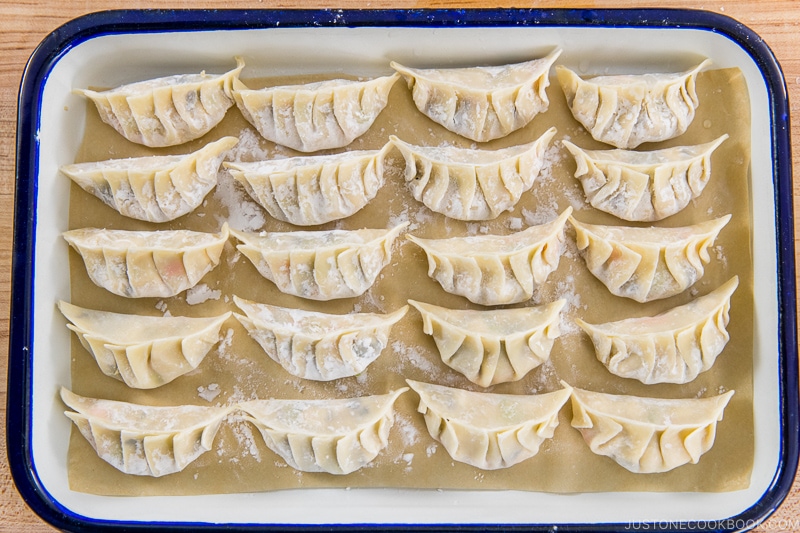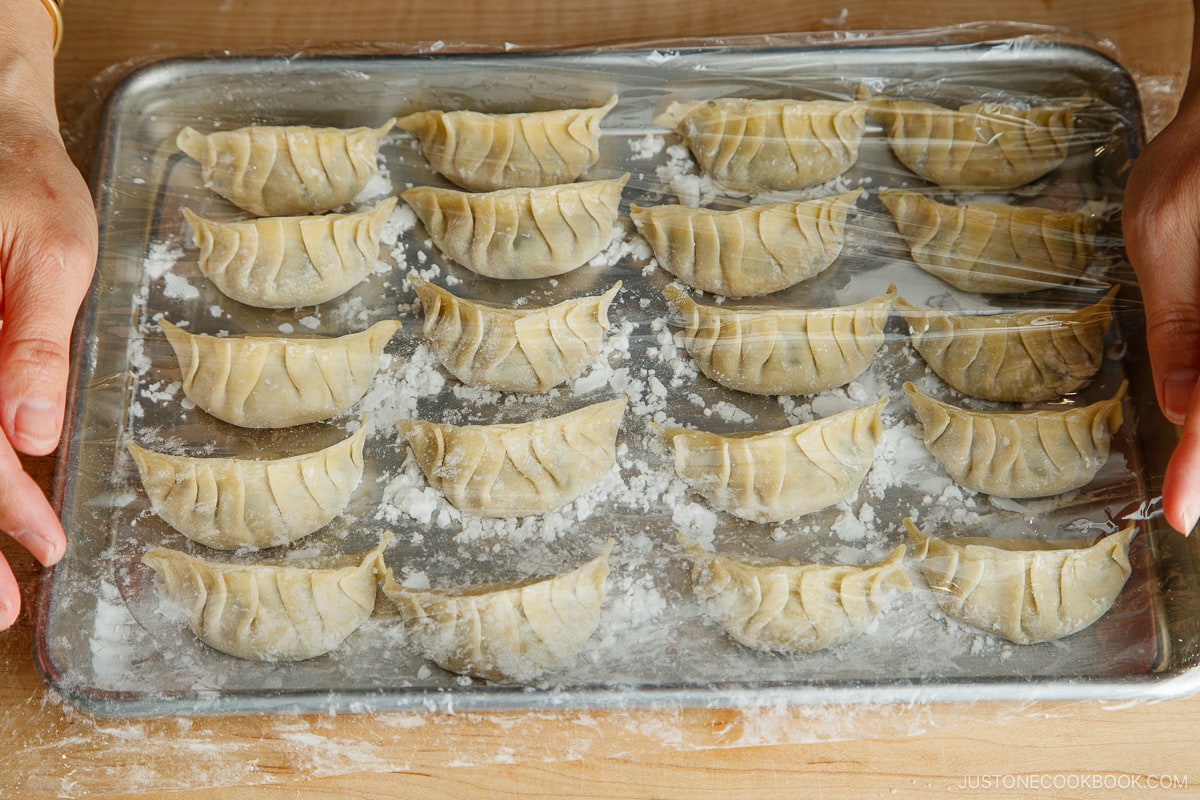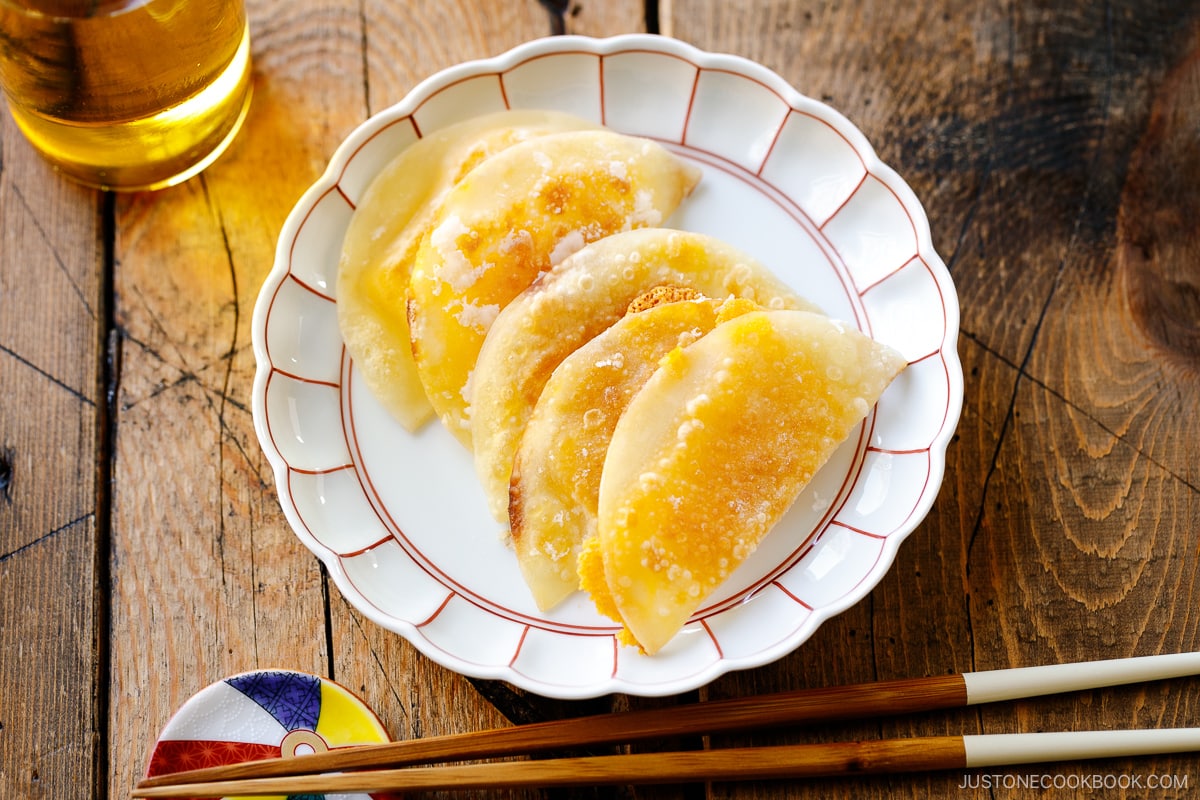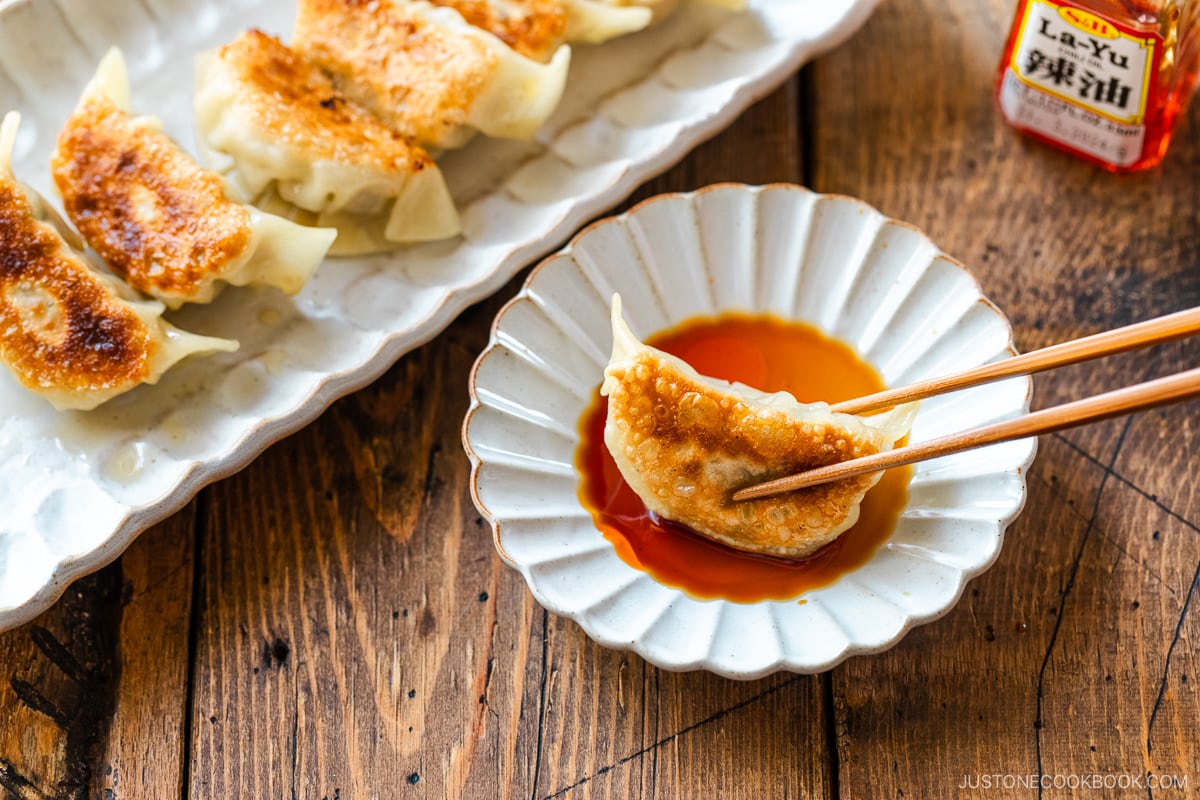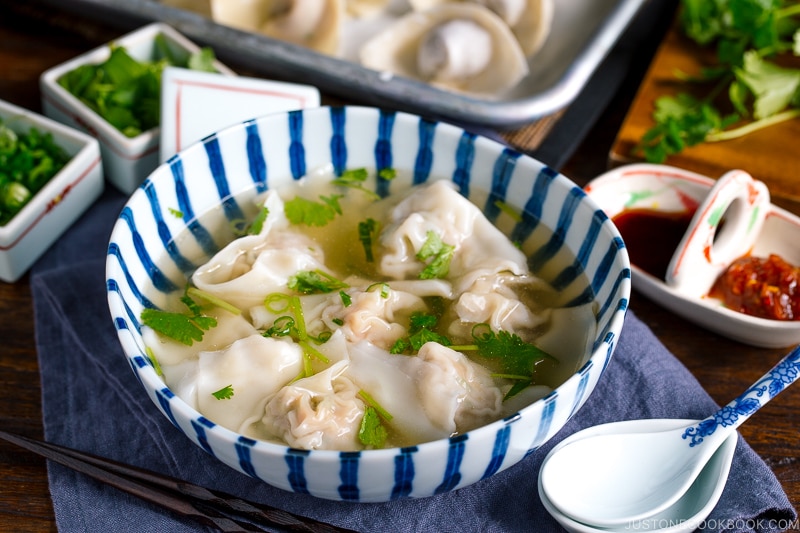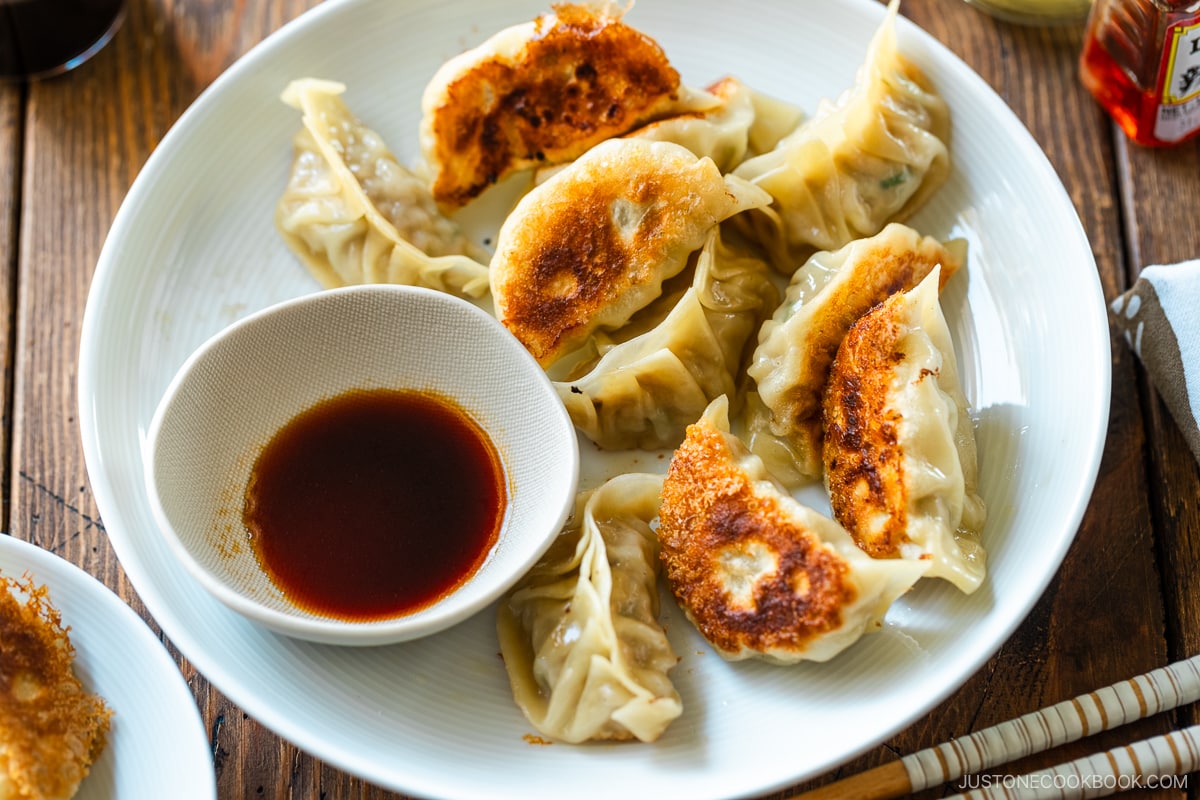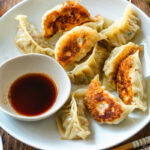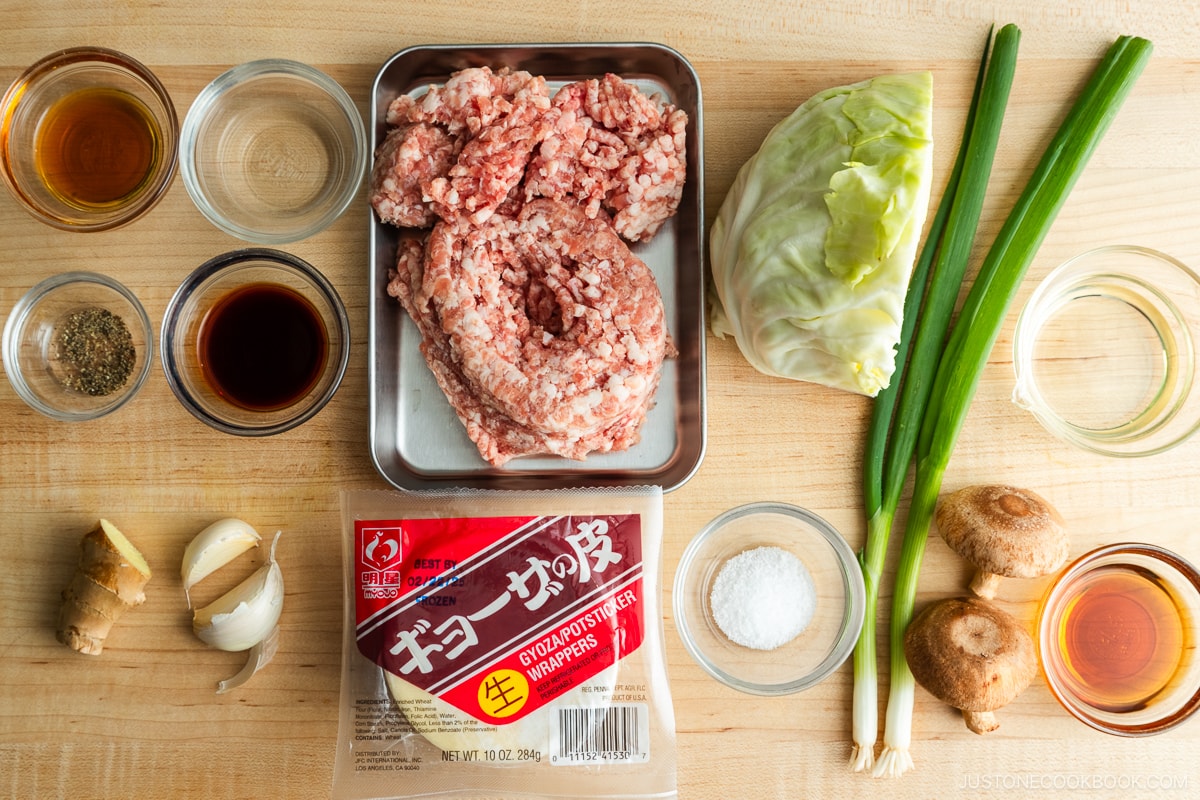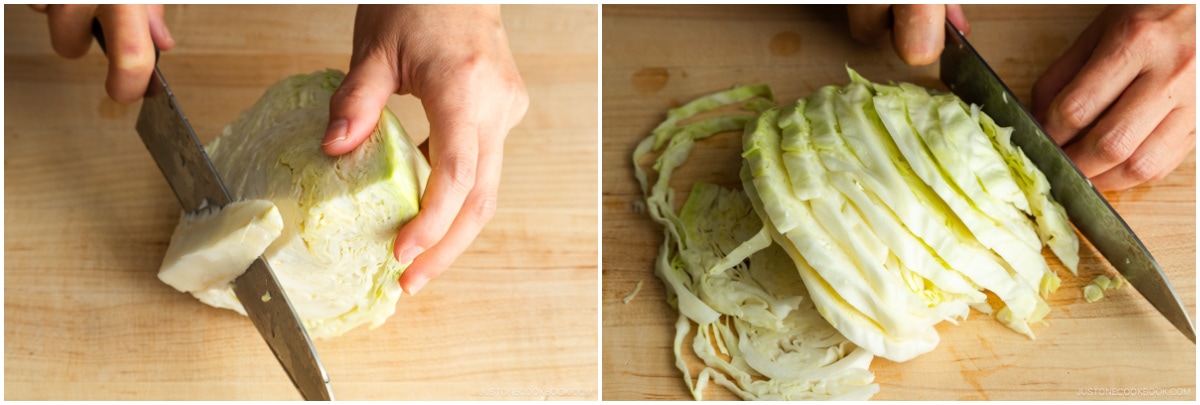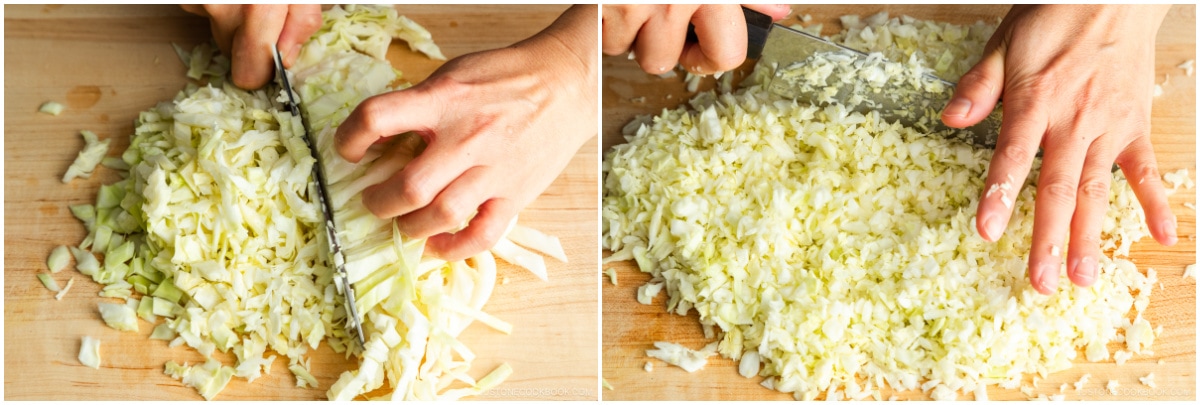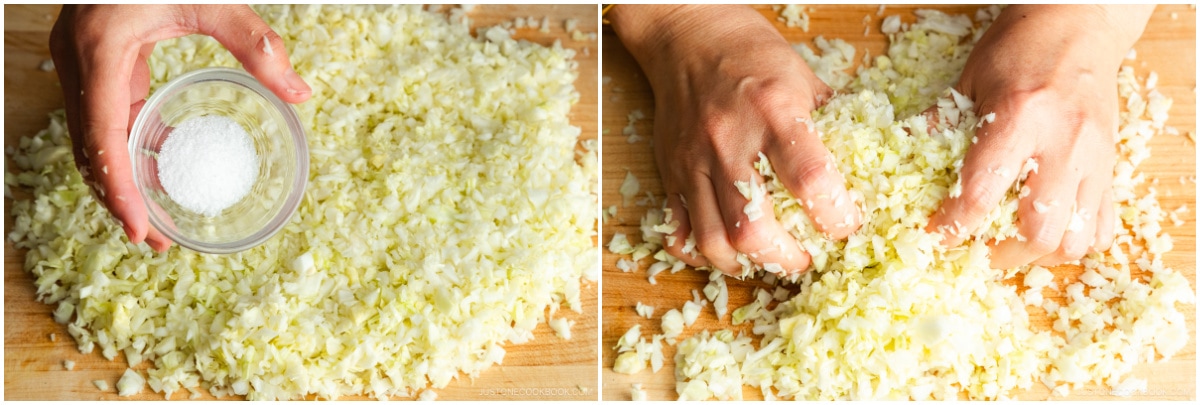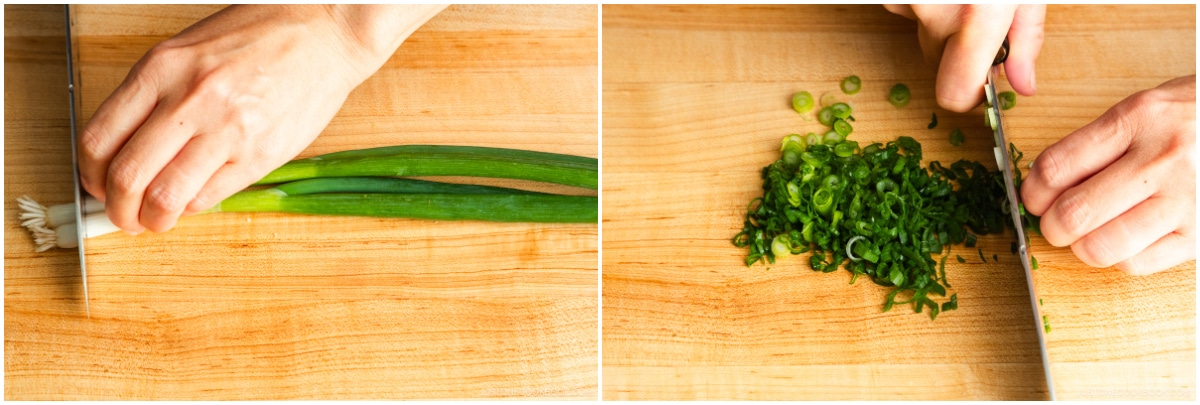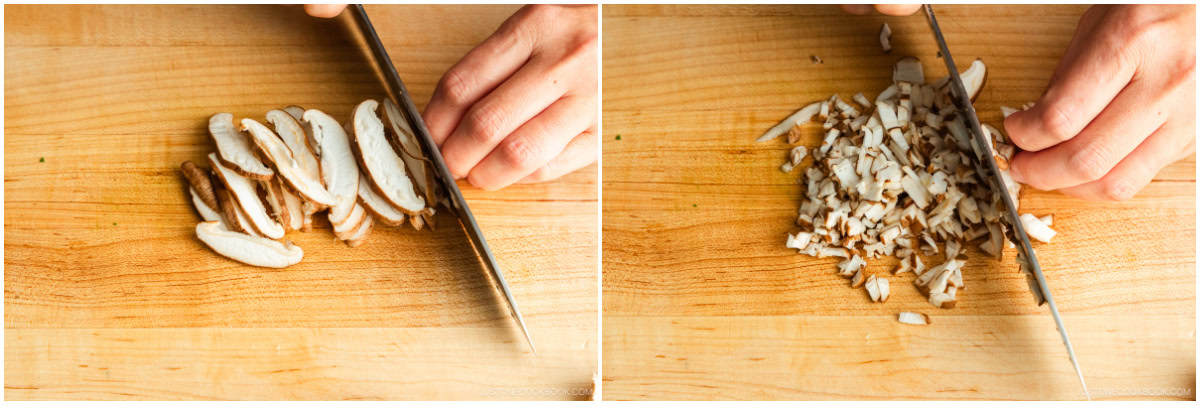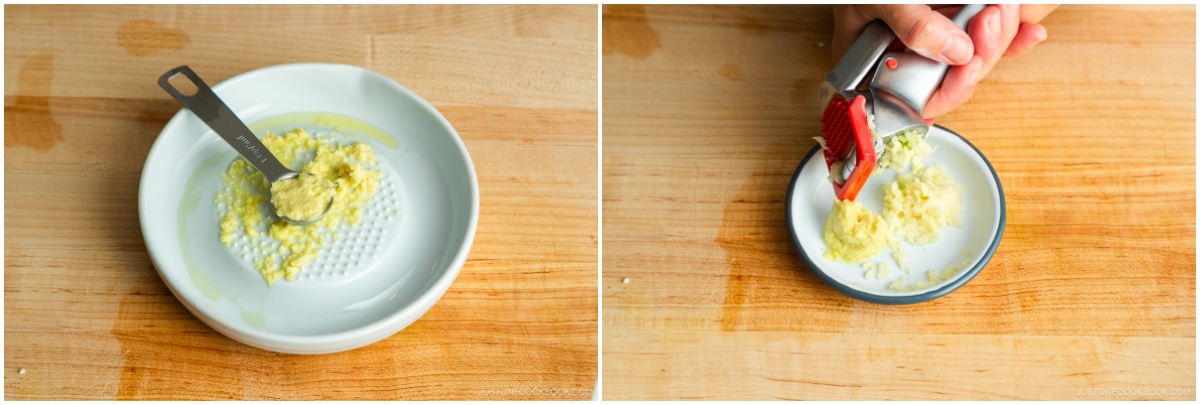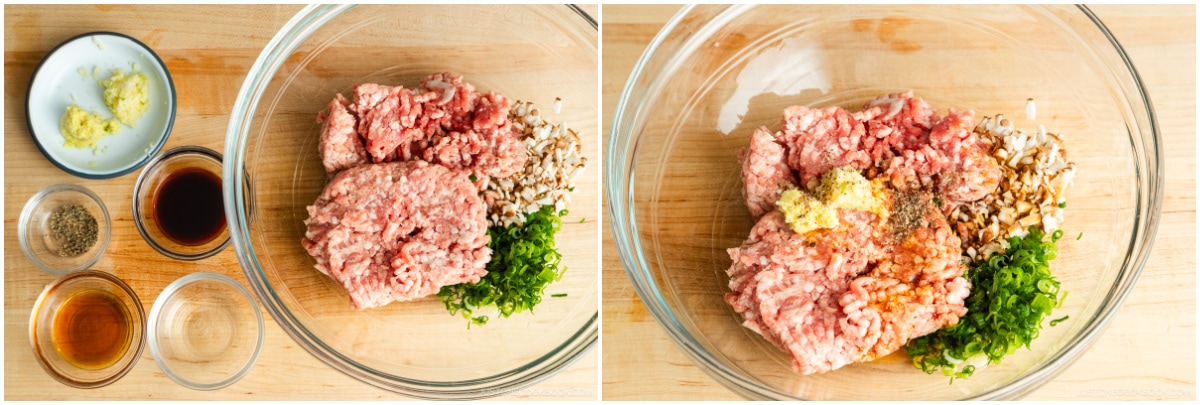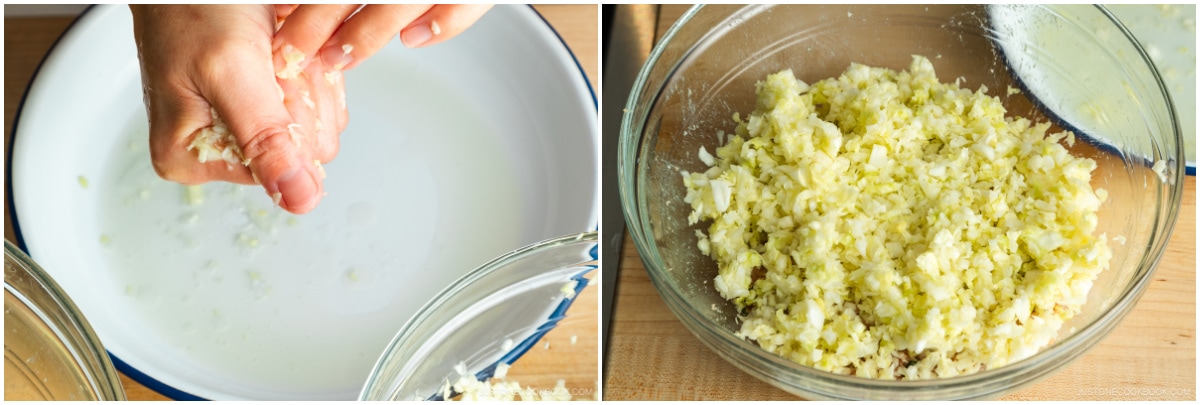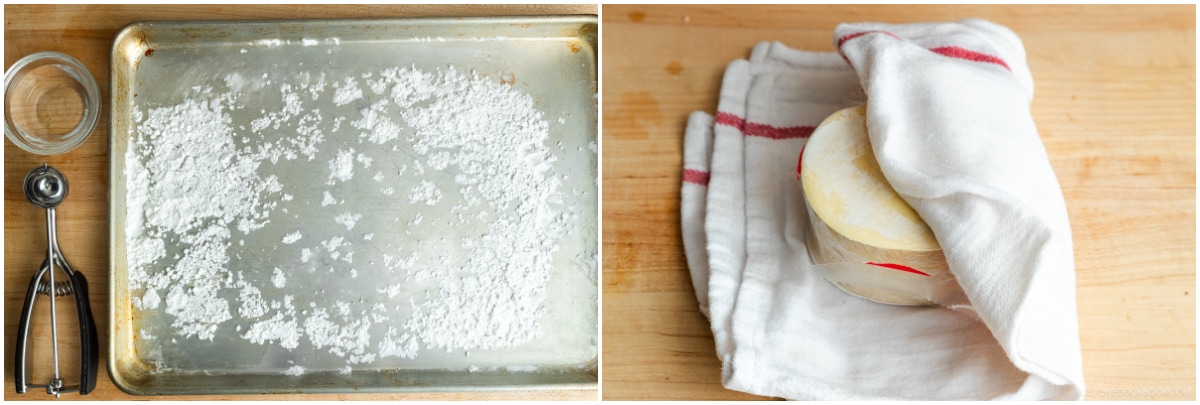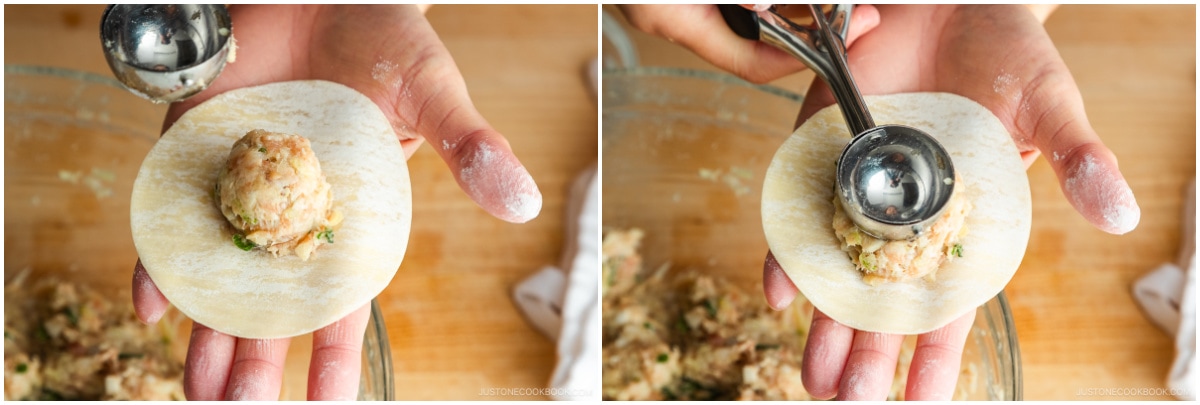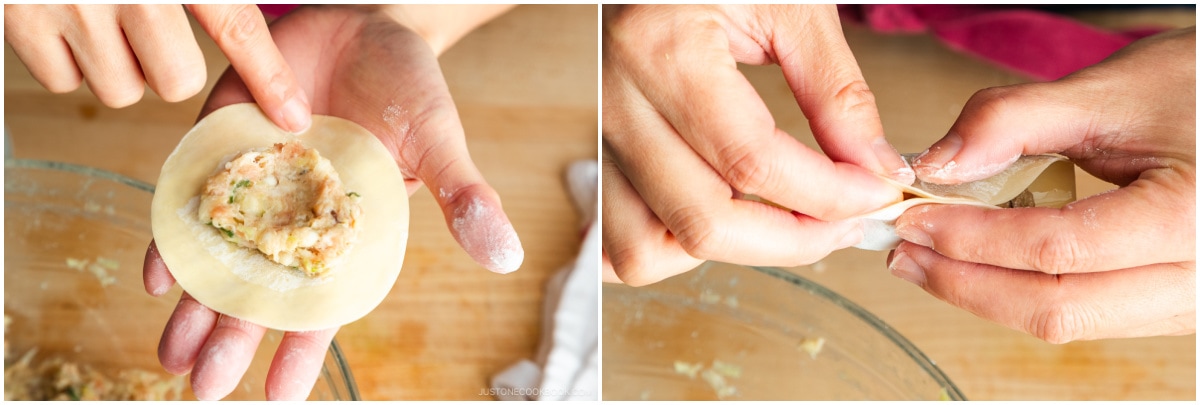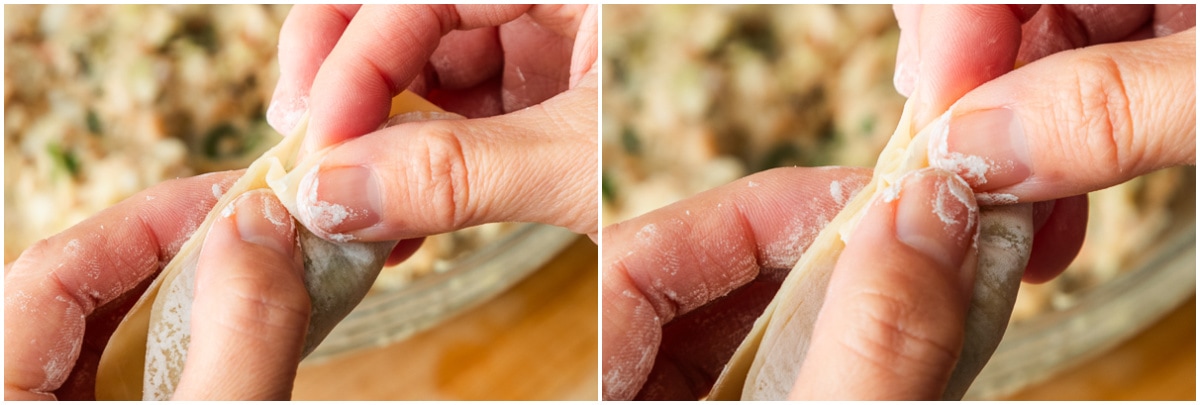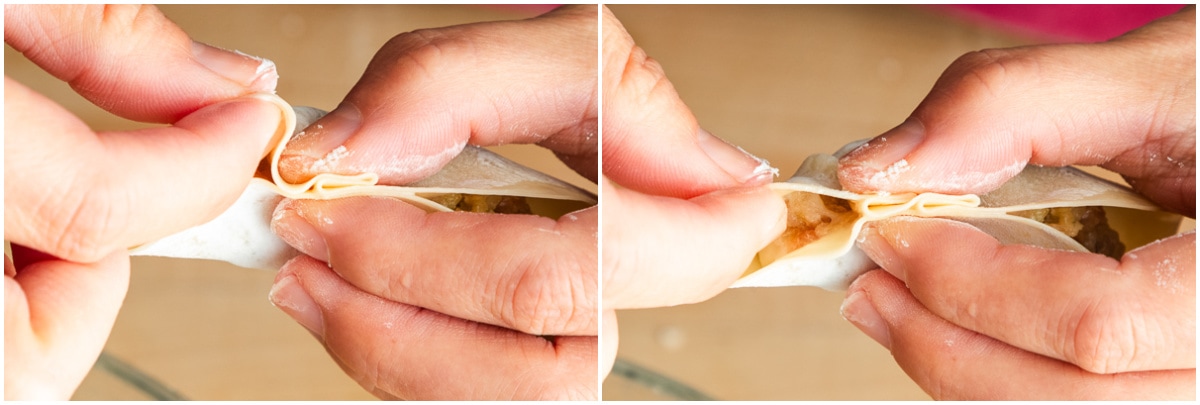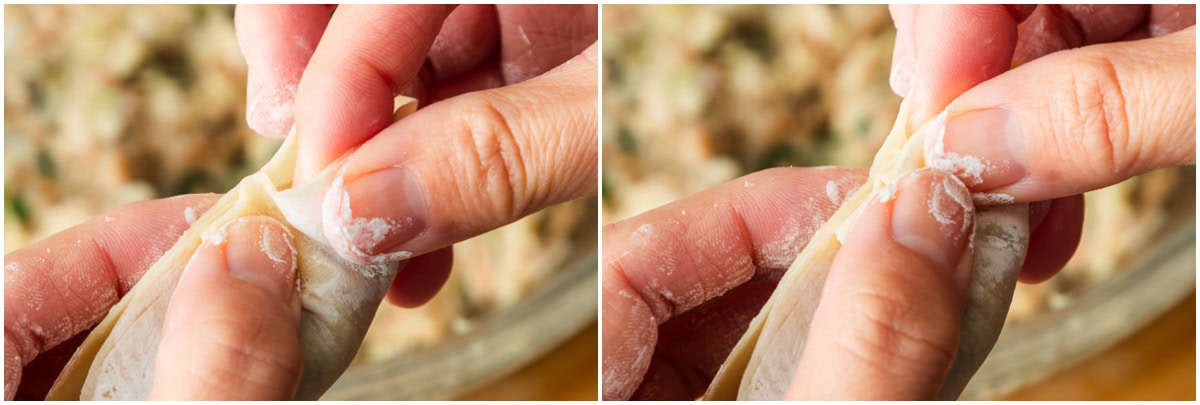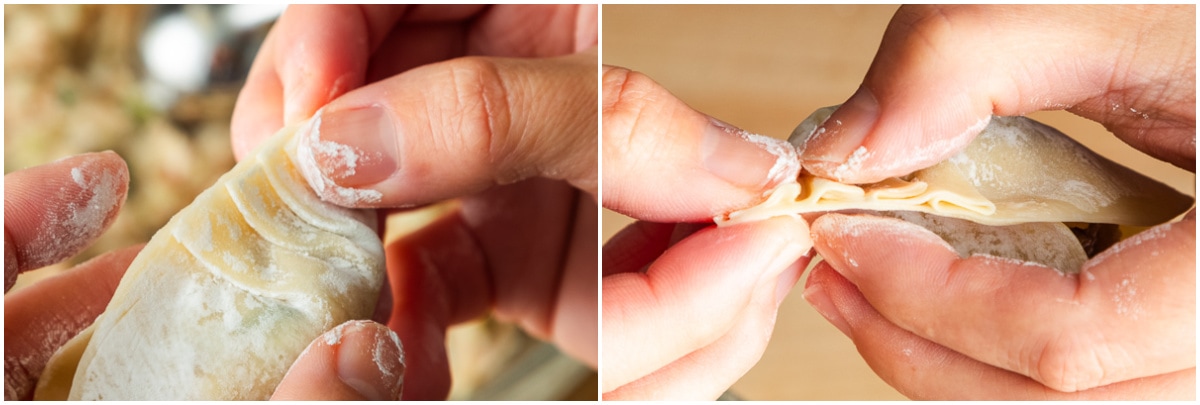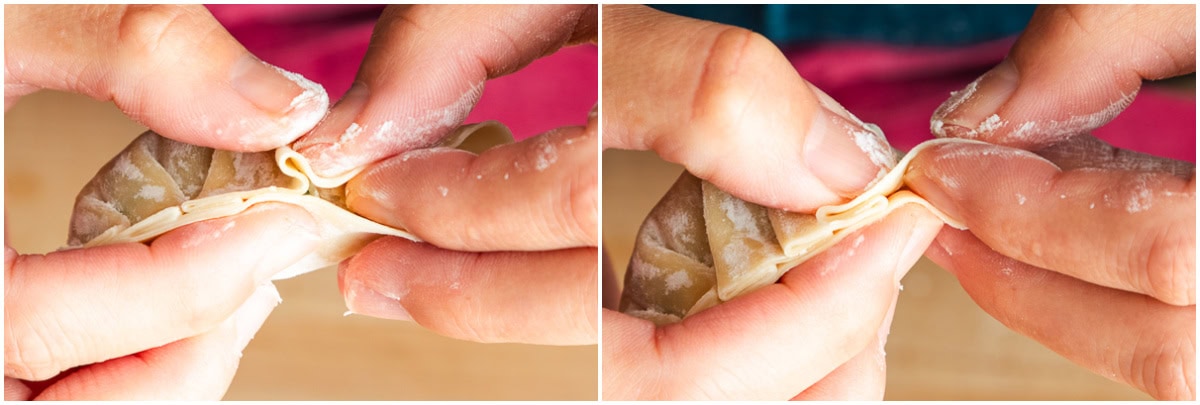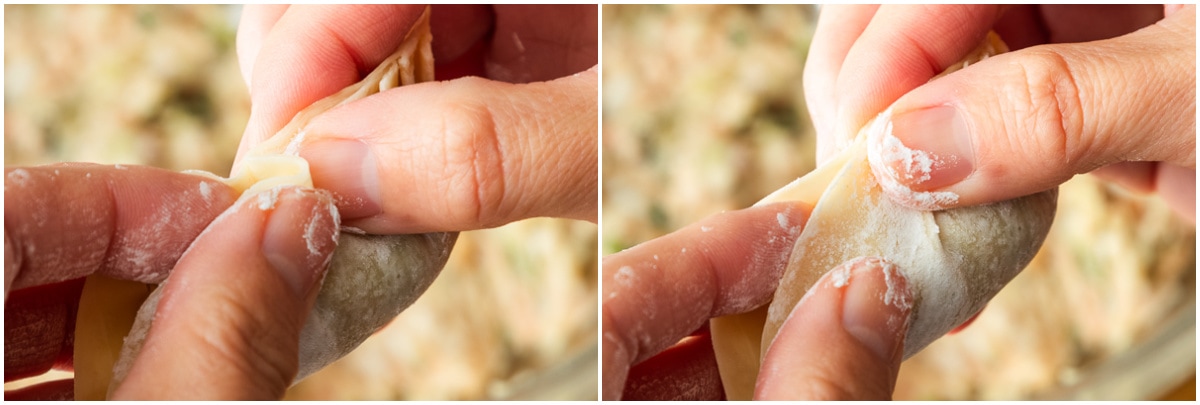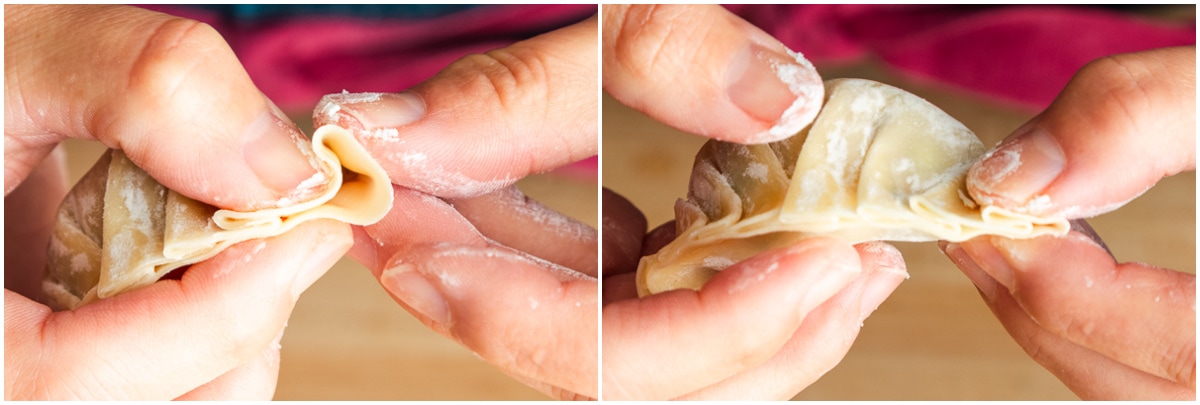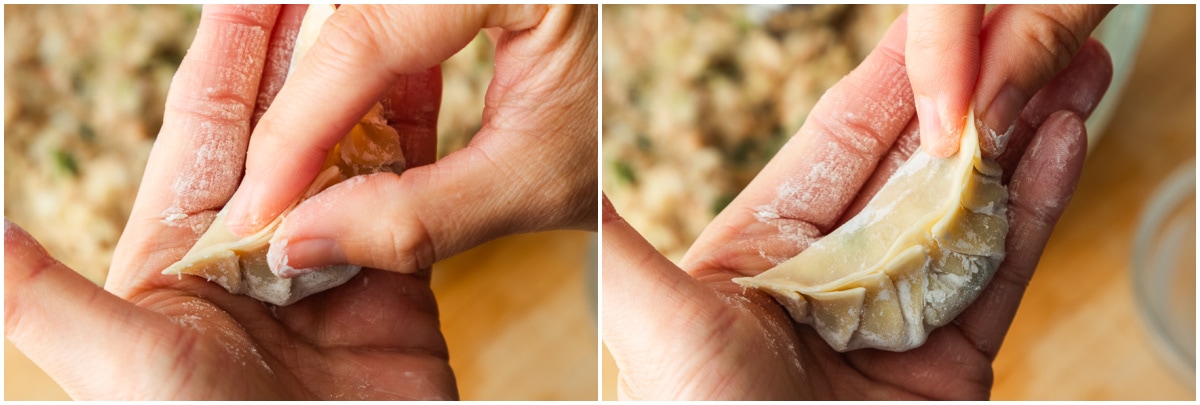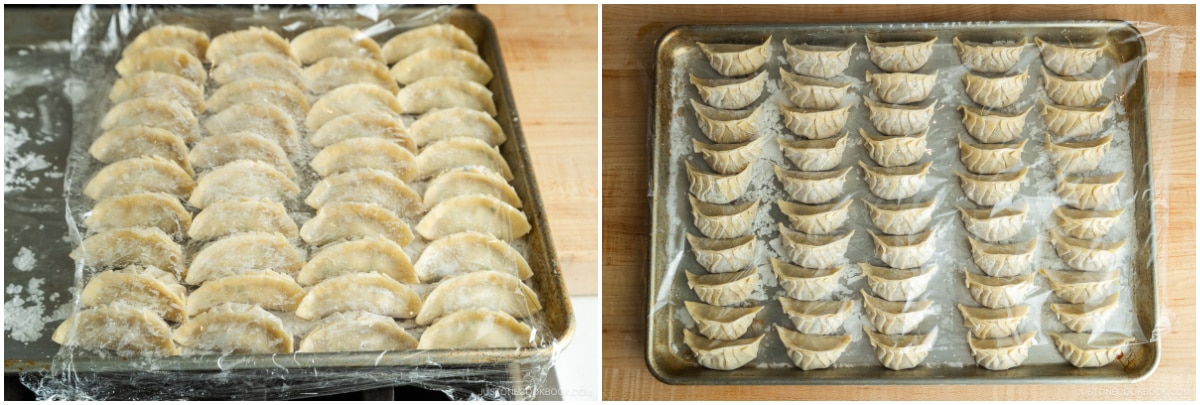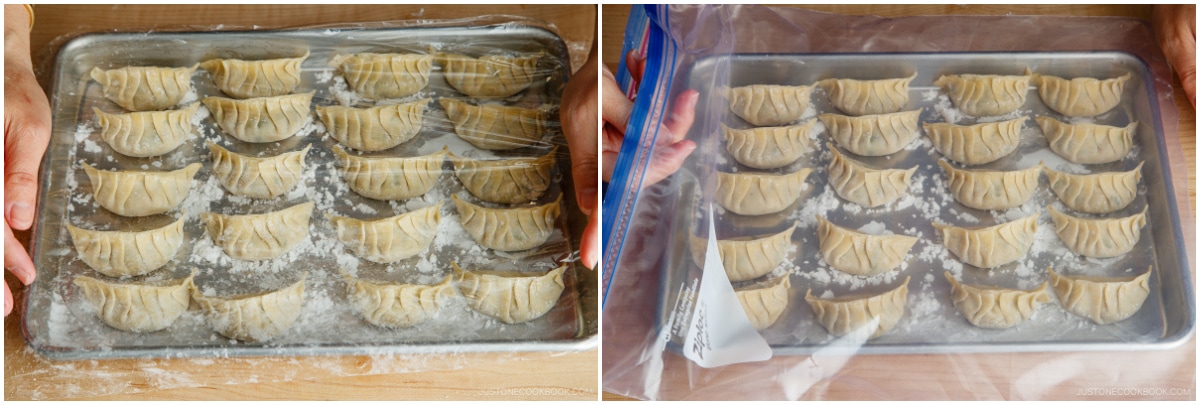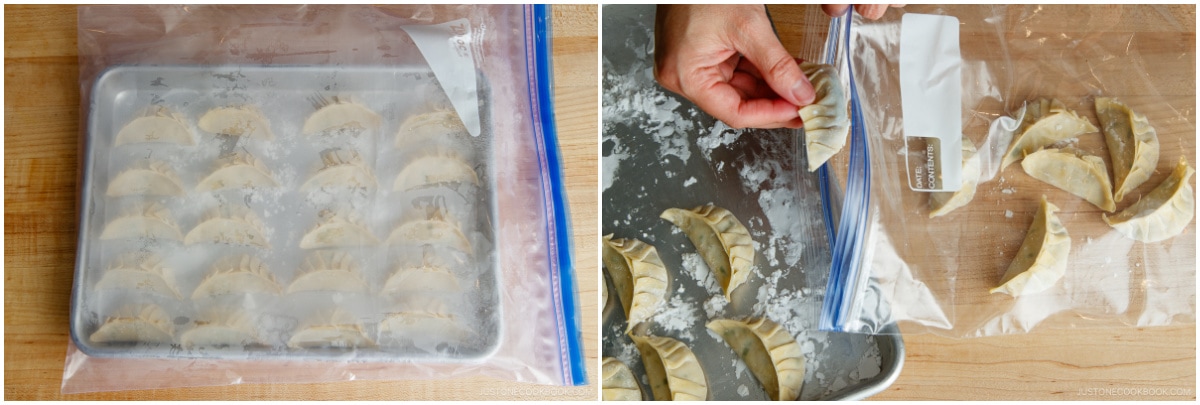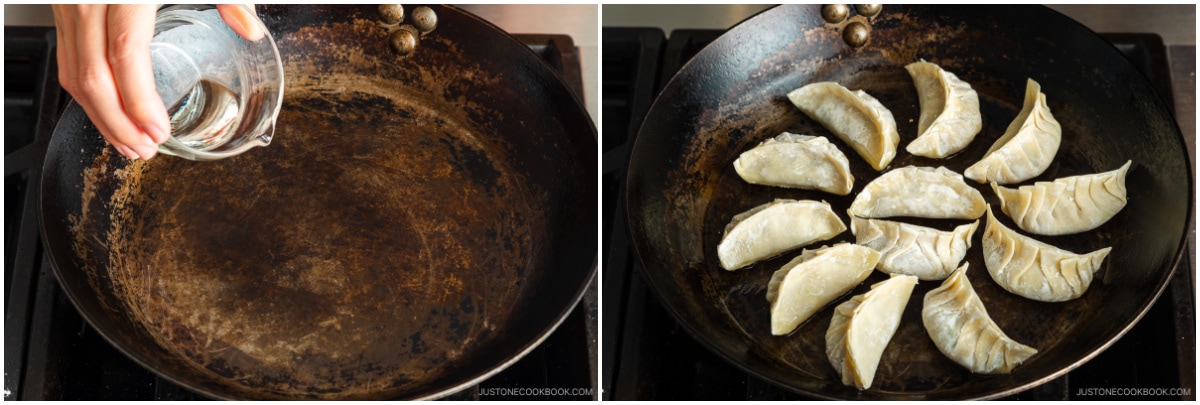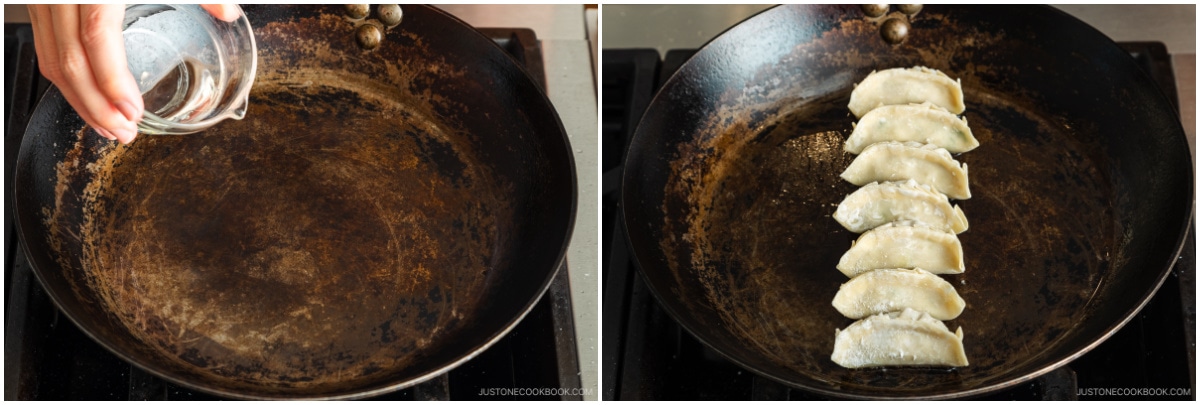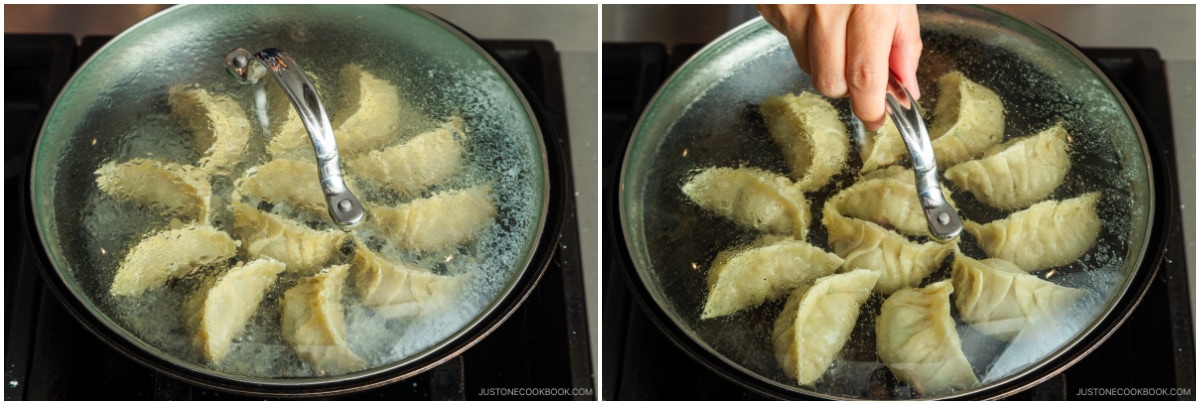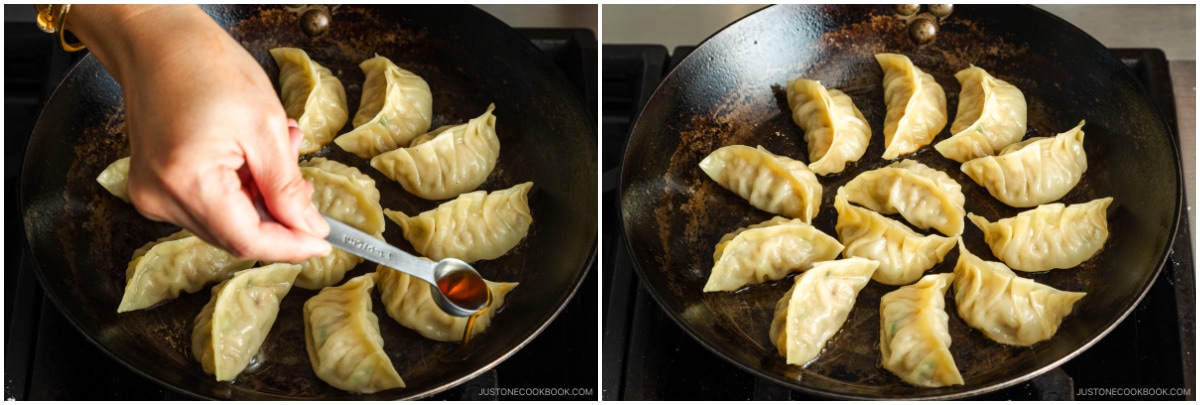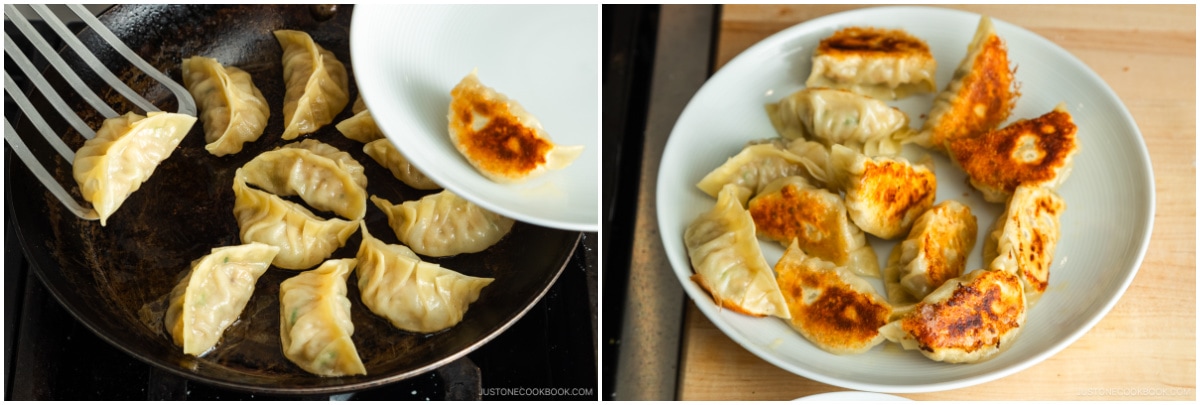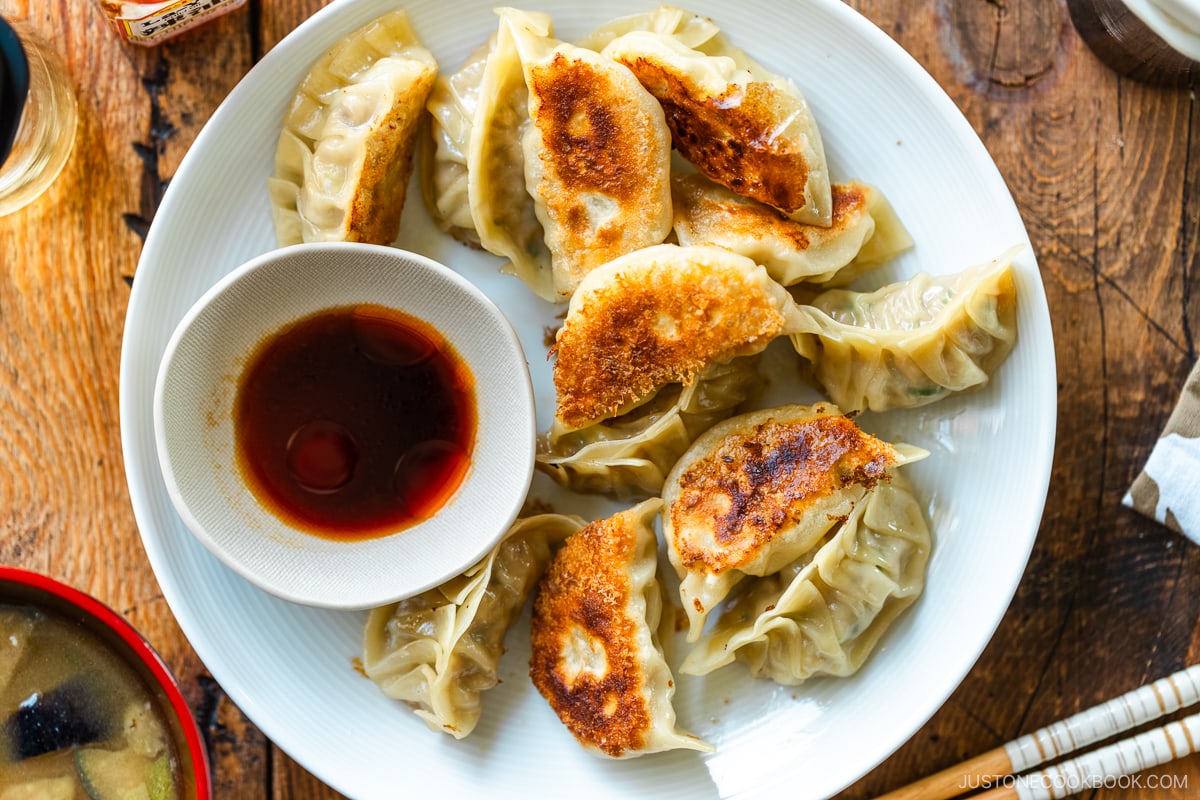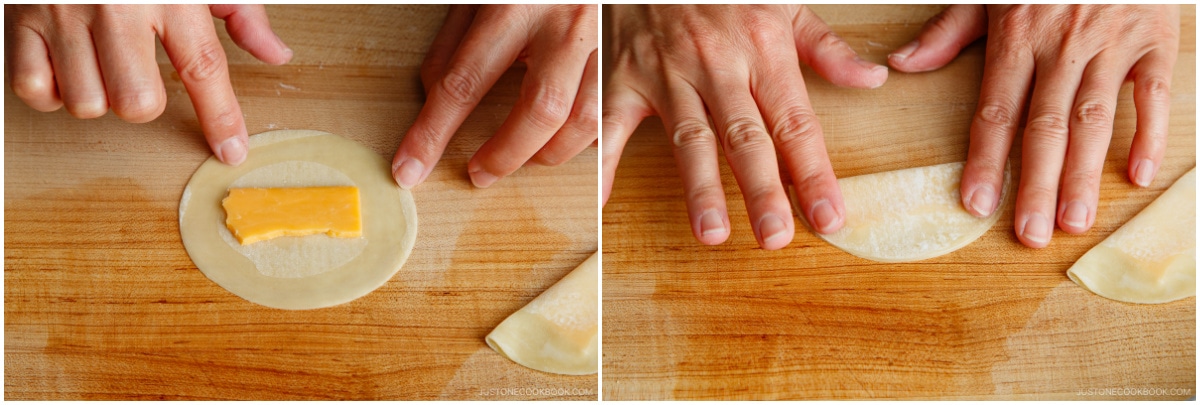Gyoza (餃子), or Japanese pan-fried dumplings, are as ubiquitous as ramen in Japan. You can find these mouthwatering dumplings being served at specialty shops, izakaya, ramen shops, grocery stores or even at festivals. While store-bought ones are convenient, you can’t beat homemade gyoza. So, let me show you how to make the best gyoza at home!
What is Gyoza?
The original Chinese dumplings are called Jiaozi (餃子). These dumplings consist of ground meat and vegetable filling wrapped into a thinly rolled piece of dough, which is then sealed by pressing the edges together. Finished jiaozi can be boiled (水餃), steamed (蒸餃), pan-fried (煎餃, we call potstickers), or deep-fried (炸餃子). So what is the Japanese version like? The key characteristic of gyoza (餃子) is its cooking method, which involves pan-frying and steaming. They are first fried in a hot pan until crispy brown on the bottom sides, then a small amount of water is added before the pan is covered to steam the entire dumplings quickly. This technique gives gyoza the best mix of textures, where you get crispy bottoms and tender soft tops that encase the juicy filling inside.
What is the Difference between Gyoza and Chinese Potstickers?
Gyoza and potstickers are prepared similarly by frying and steaming, so they are not too different. One distinctive difference is that gyoza usually comes in a smaller size with thinner skin. With thinner skin, gyoza yields a much more crispy texture and bite. The filling is also finer in texture. Some say gyoza tends to be heavier on the garlic, which is great if you like garlic. For fillings, you’ll find a variety of meat such as ground pork, beef, lamb, chicken, fish, and shrimp used in Chinese dumplings. On the other hand, ground pork is typically used in gyoza.
Ingredients You’ll Need for Gyoza
Pork — Classic gyoza usually consist of ground pork. Cabbage — Regular cabbage is commonly used for gyoza, as opposed to Chinese dumplings, which typically use napa cabbage. We use different methods to wilt the tough cabbage leaves. Some blanch them or microwave them for a minute or two. Some sprinkle salt to dehydrate the cabbage and squeeze the water out before mixing it with meat. Garlic chives — My mom adds garlic chives (nira in Japanese) to her gyoza, but I usually skip them because my children don’t like their strong taste. I add garlic chives to my Napa Cabbage Gyoza recipe. Aromatics — Garlic is commonly used in Japanese gyoza. My mom always adds grated ginger, so I do the same for my recipe. Seasonings — The seasonings are simple: sake, soy sauce, sesame oil, and a pinch of salt and pepper. In traditional Japanese cooking, you will notice we use sake when we use meat and seafood. Besides adding umami, sake helps remove unwanted smells from the meat/seafood. Alcohol evaporation takes away a gamey smell. If you don’t consume alcohol, simply omit it since garlic and ginger help remove the unwanted smell. Gyoza wrappers — I recommend getting a Japanese brand of gyoza wrappers since they are thinner than Chinese ones. I’ll talk more about this in the following section.
Be Creative! There is plenty of room for creativity when it comes to making gyoza. To change things up, I like to make different versions at home. For example, this gyoza recipe includes fresh shiitake mushrooms, my specialty! I like the meaty texture and juicy umami from shiitake mushrooms without adding more meat. For delicious filling, the rule of thumb is to consider ingredients with different textures. So feel free to experiment with different ingredients or seasonal vegetables.
Vegan-Friendly Gyoza?
If you want to make a plant-based version, try my Vegetable Gyoza. These pan-fried dumplings contain lots of rainbow vegetables and tofu. I love that I feel light and healthy after eating them!
How to Make Gyoza (Japanese Potstickers)
Making gyoza involves three steps. To save time, you can work on steps 1 and 2, freeze the gyoza, and cook them on the day of serving.
Gyoza Cooking Tips
There are a few important tips to remember when making your gyoza.
My meat-to-cabbage ratio is between 1:1 and 1:1.5. If you are curious, the typical gyoza in Japan is 1:2 (yes, way more cabbage!). Feel free to adjust as you like, including the seasonings. This gyoza recipe has the perfect amount of juiciness and tenderness inside! Draw out moisture from the cabbage. This is very important so that the gyoza wrappers don’t get soggy. After sprinkling salt on the cabbage, squeeze the water out. You’d be surprised how much water comes out! Knead the meat well with seasonings until it becomes sticky and pale. I recommend using your hand, not a spatula or spoon. If you don’t like touching raw meat, get plastic food-grade disposable gloves. Kneading makes the proteins in the meat bind together, yielding a springier and smoother texture. It also allows the seasonings to blend well with the meat. Use less than 1 tablespoon of gyoza filling. If you’re a beginner, start with a scant 3/4 tablespoon. I use a small OXO cookie scoop (1 Tbsp) and level off the filling. If you add too much filling, it will squeeze out easily. While folding, cover your gyoza wrappers with a damp paper towel or kitchen cloth. Once you open the package, the edges of the wrappers dry quickly. Covering helps keep them moist and easier to use. Cook or store the dumplings soon after they’re wrapped. Even though you draw out moisture from the napa cabbage, the filling still contains some moisture, so don’t let gyoza sit on the counter for too long. Either pan-fry them quickly or flash-freeze them (more later).
Store-bought or Homemade Wrappers
Gyoza wrappers can be purchased in Japanese or Asian grocery stores. I usually buy Myojo brand’s 10-oz wrappers, which contain about 52–54 skins. Once you open the package, cover the wrappers with a damp towel to prevent them from drying out. If you can’t find gyoza wrappers at an Asian or local grocery store or enjoy making food from scratch, I highly encourage you to make gyoza wrappers! All you need is flour, salt, and water. With practice and patience, you make delicious homemade gyoza skins in just a few hours! Here’s a detailed tutorial with the video instructions on How To Make Homemade Gyoza Wrappers.
Gyoza Folding Techniques
While Chinese dumplings have several ways to fold the wrappers, gyoza or Japanese pan-fried dumplings have just two ways: Folding pleats toward one side vs. folding pleats toward the center. Check out my post on How To Fold Gyoza. With just a little bit of practice, you will master the folding very quickly.
How to Store Gyoza
Gyoza are best stored in the freezer before they are cooked. If you properly save them, they can last up to a month in the freezer! Why don’t we cook first and freeze? When you freeze gyoza after being pan-fried, it will lose its crispness and become soggy and too soft after reheating.
What to Do with Extra Wrappers?
If you have any leftover gyoza wrappers, don’t throw them away. I love using the leftover wrappers for crispy cheese wraps. Fill the wrappers with some sliced cheese, cream cheese, or brie cheese, fold them into half and pan-fry or deep fry them. You can make these with wonton wrappers or gyoza wrappers. The golden parcels with hot, gooey melty cheese make an easy and yummy appetizer that goes well with beer!
Serve Gyoza with Dipping Sauce
Often served in a group of six or eight, Japanese enjoy gyoza as a snack and a main meal alone. They come in carbs, vegetables, and protein in one parcel. Gyoza is best when enjoyed with a simple dipping sauce of soy sauce, rice vinegar, and a bit of la-yu (Japanese chili oil) (you can make your own). It may look difficult to make Gyoza at home, but the method is fairly simple once you know how to prepare them. Part of the fun of making homemade gyoza is the process and the opportunity for creativity. You can experiment with different ingredients for the filling based on your preference. Gyoza also taste better when you can involve family or friends in making them together, making it an enjoyable activity.
More Dumpling Recipes You’ll Love
Shrimp & Pork Wonton Soup Shumai (Steamed Pork Dumplings) Gyoza with Wings (Hanetsuki Gyoza) Chicken Shiso Gyoza with Yuzu Kosho & Ponzu Sauce
Editor’s Note: The post was originally published on Feb 9, 2011. It was updated with new step-by-step and final images and the slightly revised recipe on April 13, 2024.
